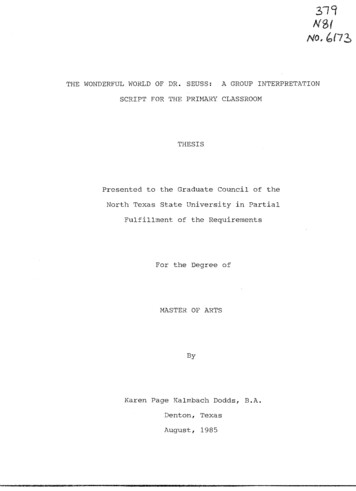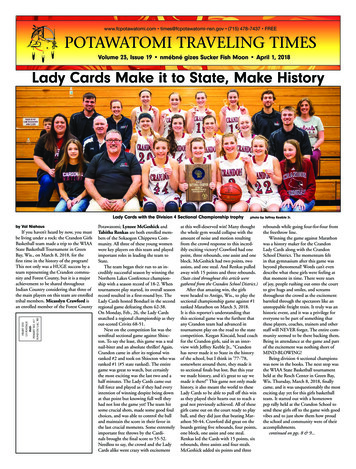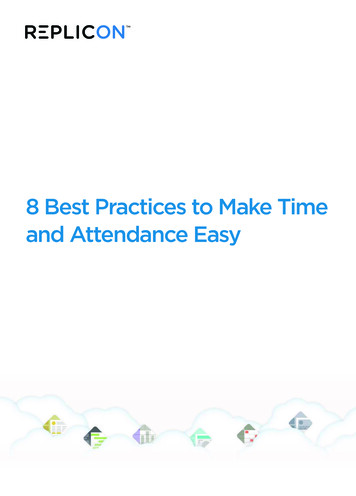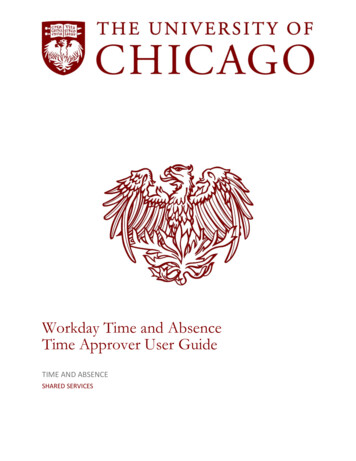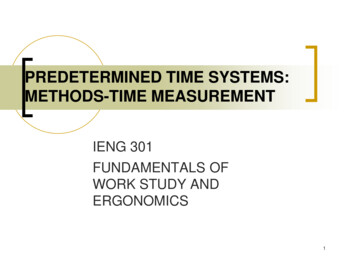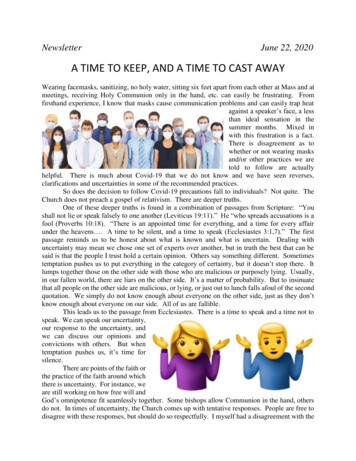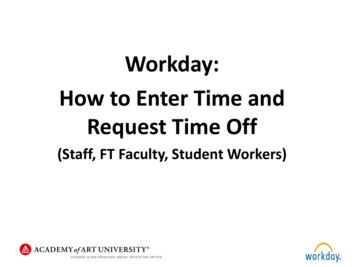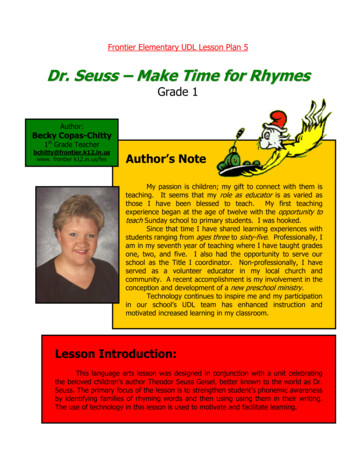
Transcription
Frontier Elementary UDL Lesson Plan 5Dr. Seuss – Make Time for RhymesGrade 1Author:Becky Copas-Chitty1st Grade Teacherbchitty@frontier.k12.in.uswww. frontier k12.in.us/fesAuthor’s NoteMy passion is children; my gift to connect with them isteaching. It seems that my role as educator is as varied asthose I have been blessed to teach.My first teachingexperience began at the age of twelve with the opportunity toteach Sunday school to primary students. I was hooked.Since that time I have shared learning experiences withstudents ranging from ages three to sixty-five. Professionally, Iam in my seventh year of teaching where I have taught gradesone, two, and five. I also had the opportunity to serve ourschool as the Title I coordinator. Non-professionally, I haveserved as a volunteer educator in my local church andcommunity. A recent accomplishment is my involvement in theconception and development of a new preschool ministry.Technology continues to inspire me and my participationin our school’s UDL team has enhanced instruction andmotivated increased learning in my classroom.Lesson Introduction:This language arts lesson was designed in conjunction with a unit celebratingthe beloved children’s author Theodor Seuss Geisel, better known to the world as Dr.Seuss. The primary focus of the lesson is to strengthen student’s phonemic awarenessby identifying families of rhyming words and then using using them in their writing.The use of technology in this lesson is used to motivate and facilitate learning.
Language Arts Subject AreasReading, Writing, ListeningReadingConcepts About Print1.1.1 - Match oral words to printed words.1.1.2 - Identify letters, words, and sentences.Phonemic Awareness1.1.4 - Distinguish beginning, middle and ending sounds in single-syllable words.1.1.7 - Create and state a series of rhyming words.Objectives:1.1.8- Add, delete or change sounds to change words.The studentswill phonemeslisten to andrespond words.to the Dr. Seuss story Green1.1.9 - Blendtwo to fourintothenrecognizableEggs andHam. Studentswill identify rhyming words from the story. Students willDecodingandWordRecognitionthen -usethese roups) to1.1.10Generatethe soundsfromall thelettersfrom ainvarietyof letterform patterns,sentencesincludingand createaclass-writtenversionofthestory.consonant blends and long- and short-vowel patterns, and blend thosesounds into recognizable words.Somecommonstudentswillbe able to fluently read, identify, and then generate1.1.11 - Readsightwords.newpairsofrhymingwordstouse incomposing1.1.14 - Read common word patterns(-ite,-ate). complete and accurate sentencesfor inclusion in a collaborative classroom story following the author’s format.WritingMostandstudentsOrganizationFocus will be able to orally identify, record, and sort rhymingwordsaccordingto andwordselectfamilies.Theythenstoriesbe ableto writesentences using1.4.1– Discussideasa focusforwillgroupor otherwriting.two strategies to plan writing.studentswillbeableto orally identify rhyming words from the storyAllEvaluation and Revisionand –thenusewritingtwo wordsin a sentence.1.4.3Revisefor othersto read.Planning PyramidApplications1.5.3 – Write simple rhymes.1.5.4 – Use descriptive words when writing.1.5.5 – Write for different purposes and to a specific audience.English and Language Conventions1.6.1 – Print legibly and space letters, words, and sentences appropriately.1.6.2 – (Sentence Structure) Write in complete sentences.1.6.3 – (Grammar) Identify and correctly use singular and plural nouns.1.6.6 – (Punctuation) Correctly use periods, exclamation points, and questionmarks at the end of sentences.1.6.7 – (Capitalization) Capitalize the first word of a sentence, names of people,and the pronoun I.1.6.8 – Spell correctly three and four letter words and grade-level-appropriatesight words.ListeningComprehension1.7.1 – Listen attentively.Speaking Applications1.7.10 – Use visual aids, such as pictures and objects, to present oralinformation.More information on Indiana Academic State g Educational Standards http://edStandards.org/Standards.htmlMCREL http://www.mcrel.org/standards/Indiana Learning Standards http://www.doe.state.in.us/standards/
ProceduresDay 11. Establish prior knowledge by asking: Have you ever been afraid to try something new for dinner?What kinds of excuses did you make? What happened when you finally tried the food?2. Read and discuss Green Eggs and Ham by Dr. Seuss. Pay special attention to the rhyming words.3. Have students reread specific passages from the story. Ask groups of students to “round up” andrecord the rhyming words. Sort them according to their word families.4. Collect and display the rhyming words in a graphic organizer (Kidspiration).Day 25. Explain to students that they will be collectively writing a rhyming story as a classroom family.Decide on a food that students might be reluctant to try (i.e. zucchini, anchovies, etc.). Eachstudent will then select two rhyming words from the lists generated on Day One (or select two newwords of their own) to include on their page of the story.6. Have the students complete sentences such as the following.I will not eat in/on a .I will not eat with a .I do not like can’t you see!7. Have students publish their sentences using the Danas, Word-pad, Co-Writer, or pencil-and–paper.8. Give students time to illustrate their passages.9. As a class, write an ending in which the final outcome has the main character trying the food, atlast. Decide on and publish a final response to the tasting.10. Collate and bind the collective story.11. Share and display the work for others to enjoy.
Assessment1. The students will be evaluated using the attached Grade 1, writing rubric.The data from the rubrics will be used to make comparisons between students’writing samples.2. Anecdotal notes may be taken to assess/confirm student’s ability to read theselection, identify rhyming words, sort words into word families, generate other rhymingwords, and compose written sentences.
Materials Green Eggs and Ham by Dr.SeussChart paperPaperPencilsDANA’sWord PadBy the end of the 2-day lesson,Co-Writerstudentswill have been exposed to a varietyWYNN Softwareof writing tools. They will have had theKidspirationopportunity to select one of these toolsto publish their work. We hope to findthat giving students choices in theirwriting will improve their writing.UDL Team ObjectiveTeacher/Learner LibraryRelated acher Resourceshttp://falcon.jmu.edu/ ,1871,48624-196200-51104362,00.htmlAuthor’s Biographyhttp://www.catinthehat.org/history.htm
ModificationsLearning BarrierPossible SolutionsStudent cannot read at gradelevel.1. Text to Speech Software.2. Buddy read.Student has difficultycomprehending the material.1. Visually map concepts.Student has difficulty masteringthe vocabulary of the unit.Student needs instructionalmaterial in a language other thanEnglish.Student has difficulty withhandwriting (speed or accuracy).Student needs additionalchallenges.1. Assist students inidentifying and usingWord Wall words.2. Visually map sorted wordfamily words.3. Visually map concepts.1. Use text to Speech toconvert story into otherlanguages.2. Use multiple visualrepresentations ofconcepts.1. Use Danas, WordPad, orother grade-appropriatehardware/tools.2. Use cooperative learningpartners to transposeresponses.1. Encourage independentcompositions2. These students couldcompose the beginningor ending to the storyusing Co-writer.3. Extend the lesson tosurvey, chart, andevaluate studentresponses to eating atypically undesirable foodsample.Student has difficulty withcalculating activities.Student needs help withconducting research.1. Use a webquest tofacilitate research.Weblink / Resources
Dr. Seuss – Make Time for Rhymes Grade 1 Lesson Introduction: This language arts lesson was designed in conjunction with a unit celebrating the beloved children’s author Theodor Seuss Geisel, better known to the world as Dr. Seuss. The primary focus of the lesson is to strengthen student’s phonemic awareness by identifying families of rhyming words and then using using them in their .

